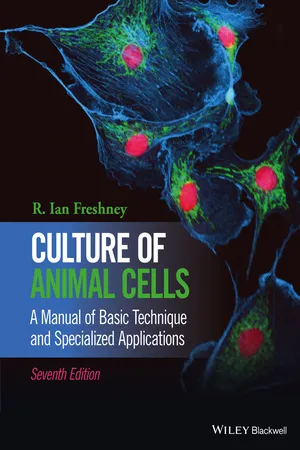
Culture of Animal Cells
A Manual of Basic Technique and Specialized Applications
- English
- ePUB (mobile friendly)
- Available on iOS & Android
About this book
Since the publication of the sixth edition of this benchmark text, numerous advances in the field have been made – particularly in stem cells, 3D culture, scale-up, STR profiling, and culture of specialized cells. Culture of Animal Cells: A Manual of Basic Technique and Specialized Applications, Seventh Edition is the updated version of this benchmark text, addressing these recent developments in the field as well as the basic skills and protocols.
This eagerly awaited edition reviews the increasing diversity of the applications of cell culture and the proliferation of specialized techniques, and provides an introduction to new subtopics in mini-reviews. New features also include a new chapter on cell line authentication with a review of the major issues and appropriate protocols including DNA profiling and barcoding, as well as some new specialized protocols. Because of the continuing expansion of cell culture, and to keep the bulk of the book to a reasonable size, some specialized protocols are presented as supplementary material online.
Culture of Animal Cells: A Manual of Basic Technique and Specialized Applications, Seventh Edition provides the most accessible and comprehensive introduction available to the culture and experimental manipulation of animal cells. This text is an indispensable resource for those in or entering the field, including academic research scientists, clinical and biopharmaceutical researchers, undergraduate and graduate students, cell and molecular biology and genetics lab managers, trainees and technicians.
Frequently asked questions
- Essential is ideal for learners and professionals who enjoy exploring a wide range of subjects. Access the Essential Library with 800,000+ trusted titles and best-sellers across business, personal growth, and the humanities. Includes unlimited reading time and Standard Read Aloud voice.
- Complete: Perfect for advanced learners and researchers needing full, unrestricted access. Unlock 1.4M+ books across hundreds of subjects, including academic and specialized titles. The Complete Plan also includes advanced features like Premium Read Aloud and Research Assistant.
Please note we cannot support devices running on iOS 13 and Android 7 or earlier. Learn more about using the app.
Information
CHAPTER 1
Introduction
1.1 HISTORICAL BACKGROUNd
Table of contents
- Cover
- Titlepage
- Copyright
- Dedication
- List of Color Plates
- List of Protocols
- List of Minireviews
- Preface and Acknowledgments
- Abbreviations
- About the Companion Website
- CHAPTER 1 Introduction
- CHAPTER 2 Biology of Cultured Cells
- CHAPTER 3 Laboratory Design and Layout
- CHAPTER 4 Equipment and Materials
- CHAPTER 5 Aseptic Technique
- CHAPTER 6 Safety, Bioethics, and Validation
- CHAPTER 7 Culture Vessels and Substrates
- CHAPTER 8 Defined Media and Supplements
- CHAPTER 9 Serum-Free Media
- CHAPTER 10 Preparation and Sterilization
- CHAPTER 11 Primary Culture
- CHAPTER 12 Subculture and Cell Lines
- CHAPTER 13 Authentication and Validation
- CHAPTER 14 Microbial Contamination
- CHAPTER 15 Cryopreservation and Banking
- CHAPTER 16 Cloning and Selection
- CHAPTER 17 Cell Sorting
- CHAPTER 18 Cell Line Characterization
- CHAPTER 19 Differentiation
- CHAPTER 20 Three-Dimensional Culture
- CHAPTER 21 Scale-up and Automation
- CHAPTER 22 Senescence, Immortalization, and Transformation
- CHAPTER 23 Quantitation
- CHAPTER 24 Cytotoxicity
- CHAPTER 25 Culture of Specific Cell Types
- CHAPTER 26 Stem Cells
- CHAPTER 27 Training Programs
- CHAPTER 28 Problem Solving
- CHAPTER 29 In Conclusion
- Appendix I Calculations and preparation of reagents
- APPENDIX II Glossary
- Index
- Links
- Supplementary Images
- EULA